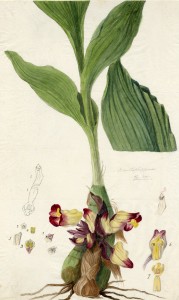A new RBGE publication documents, and pays belated tribute, to a pair of intrepid and enterprising botanists. The latest in a series of studies by Henry Noltie on little-known collections in the RBGE herbarium and archives. As with previous work the specimens form part of the herbarium of George Walker-Arnott (1799–1868), which is one of the most significant subsets of the RBGE herbarium, and was deposited on permanent loan by the University of Glasgow in 1966.
Much research was required to establish biographical facts about George Warren Walker (1778–1843) and his Scottish wife Anna Maria Patton (c. 1778–1852), and much of the little so far published on them proved to be wrong; their dates of birth and death were not even known. He was son of an Anglican clergyman, who became a soldier and spent his career in India and Ceylon; she was the daughter of an East India Company soldier who made a fortune, bought an estate in Fife, and acted for a time as Governor of St Helena. After soldiering in India, Colonel Walker was appointed to an administrative army post in Ceylon, and from their earliest days there they led an active life, Anna Maria being the first European woman to climb the sacred mountain of Adam’s Peak in 1820. The couple came on a home leave spent in Edinburgh, in the newly built Carlton Street; looking for a hobby to pursue on their return to Ceylon, they were wooed by Robert Graham, Regius Keeper of RBGE, and William Hooker, Professor of Botany at Glasgow, who were on the lookout for correspondents to send plants back from little-known corners of the globe. The Walkers worked out a strategy – he would do the collecting and classification, and she would paint the specimens (see Illustration).
Dried specimens, seeds, live orchid plants and drawings came flooding back to Graham (who was negligent) and Hooker (who was busy) and it fell to Arnott to do most of the research on them. He published 58 as new species in a paper with the off-putting title Pugillus Plantarum Indiae Orientalis (‘a handful of East Indian plants’) written in Latin, published in an obscure German journal. Even working out the correct date of publication of this work proved problematic, the resolution (1837) eventually being found in a letter in an archive in Calcutta. Of the living plants only a single orchid was published in the Botanical Magazine, and very few of the novelties among the herbarium materials were described after Arnott’s initial paper, so that credit for the discovery of many plants that they were the first to collect went to later botanists. In compiling the new book visits were made to Geneva to see Graham’s set of specimens and to Kew, to see Hooker’s; but the book is not concerned only with the specimens – two other bodies of work emerged: Mrs Walker’s botanical drawings – mainly at Kew, but some in the Natural History Museum in the collection of their friend the EIC surgeon Robert Wight who had visited them in Ceylon in 1836; and 17 letters written by the Walkers to Hooker from Ceylon (and later ones from India by Mrs Walker), and her journals of their two major plant collecting expeditions. These are fascinating documents not only for their contents, and their complaints of non-acknowledgement of their significant hard work and achievements, but unusual as very few of Hooker’s colonial correspondents were women.
The book therefore contains a catalogue of the Walker specimens on which new species were based by Arnott and Hooker (the ‘types’), a catalogue of her drawings (which are mainly of orchids), and transcripts of all her letters. The book also has an introduction putting the Walkers’ collecting activities in historical context, and in terms of the vegetation of Ceylon; short accounts of the Walker’s lives; a gazetteer of their collecting localities; and a listing of the 64 flowering plants (and 4 ferns) named after them. Professor David Mabberley has described the work as ‘a great contribution to botanical scholarship’, expressing surprise at ‘how much “on the public record” has had to be corrected’.
Several outstanding discoveries relating to the Walkers remain to be made, and may be with descendants of whom there must be many – in particular whereabouts of portraits of Colonel Robert Patton last seen in 1938, the oil landscape paintings Anna Maria made in St Helena, and somewhere there must surely be a portrait of her, as her sister Sarah, Lady Torrens was painted by John Linnell, and her brother John Wogan Patton by George Chinnery.
The Botanical Collections of Colonel & Mrs Walker: Ceylon, 1830–1838, by H.J. Noltie. ISBN 978-1-906129-89-7.
Obtainable from Press & Publications, RBGE (pps@rbge.org.uk) . Price £25 (paperback i–ix; 1–270; 18 figs b/w).
You can read more about Anna Maria Walker on Wikipedia.


1 Comment
1 Pingback